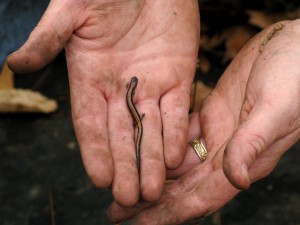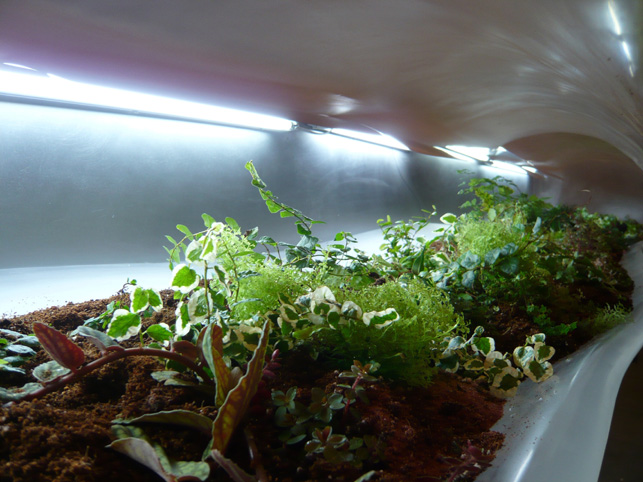Morning Eye Candy: Tree Dance
Posted in Photography on December 2 2010, by Plant Talk
The dance of the conifers and the deciduous. That’s in The Nutcracker Suite, right?
Silhouettes (photo by Ivo M. Vermeulen)

Inside The New York Botanical Garden
Posted in Photography on December 2 2010, by Plant Talk
The dance of the conifers and the deciduous. That’s in The Nutcracker Suite, right?
Silhouettes (photo by Ivo M. Vermeulen)
Posted in Photography on December 1 2010, by Plant Talk
Happy Hanukkah! May your holiday be full of family, friends, and light.
Holiday Lights at the Garden (photo by Ivo M. Vermeulen)
Posted in Science, Video on December 1 2010, by Plant Talk
 |
Rustin Dwyer is Visual Media Production Specialist at The New York Botanical Garden. |
 The 50-acre native forest at The New York Botanical Garden is a very special section of New York City. It’s the largest and oldest remnant of old growth forest around, and it’s right here in the Bronx! It’s almost like a time machine that gives a faint glimpse of the past. Strolling through, it’s not hard to imagine the kind of environments Henry Hudson and the Lenape people walked through. (For more on this subject check out the WLC’s Welikia project, previously known as Manhatta)
The 50-acre native forest at The New York Botanical Garden is a very special section of New York City. It’s the largest and oldest remnant of old growth forest around, and it’s right here in the Bronx! It’s almost like a time machine that gives a faint glimpse of the past. Strolling through, it’s not hard to imagine the kind of environments Henry Hudson and the Lenape people walked through. (For more on this subject check out the WLC’s Welikia project, previously known as Manhatta)
An ongoing survey at The Garden hopes to shed some light, sometimes literally, on a resident of the forest often overlooked — the tiny salamander. In particular, the terrestrial redback salamander, Plethodon cinereus. These little guys are one of the key species in the ecology of the forest. According to one of the wildlife biologists conducting the survey (Michael McGraw from Applied Ecological Services) the Redback salamander is thought to be the most abundant form of biomass in some northern deciduous forests. In a suitable area, you may be able to see one “under any rock you flip.” That’s a lot of amphibians!
The survey consists of a series of “cover boards” spread out strategically across the forest. These boards are simply rubber mats that provide a nice, cool dark place that salamanders like to congregate under (much like densely packed leaf mass). These boards are periodically checked, with biologists taking note of the number, size and significant features of any salamanders they may find. It gets a little dirty and the salamanders are tiny, quick and extremely squirmy, but the biologists and a few volunteer citizen scientists braved through to successfully gather their data during their latest visit.
Check out a video of their work featuring Forest Manager Jessica Schuler after the jump!
Posted in Photography on December 1 2010, by Plant Talk
Like a strange red star
Fallen from a galaxy
far away. One leaf.
Japanese Maple Leaf (photo by Ivo M. Vermeulen)
Posted in Learning Experiences on November 30 2010, by Plant Talk
Terrariums are hot.
They’re in the New York Times, they’re a great craft project for kids, they’re traditional, they’ve got personality, they can be tiny, made from found objects, or bought from a fancy store; you can wear them, or you can decorate your tree with them, and now you can marvel at them at one of the world’s finest modern art museums.
 Our friend and fellow New York City institution, MoMA, has gotten in on the terrarium trend with the installation of two absolutely astonishing terrariums in their 53rd Street lobby by the garden designer and terrariumist, Paula Hayes. Paula’s fantastic installation (be sure to watch the video) are definitely a step beyond what most of us are used to cobbling together in an old fish tank or cookie jar, but that doesn’t mean they’re beyond our reach.
Our friend and fellow New York City institution, MoMA, has gotten in on the terrarium trend with the installation of two absolutely astonishing terrariums in their 53rd Street lobby by the garden designer and terrariumist, Paula Hayes. Paula’s fantastic installation (be sure to watch the video) are definitely a step beyond what most of us are used to cobbling together in an old fish tank or cookie jar, but that doesn’t mean they’re beyond our reach.
Posted in Gardening Tips on November 30 2010, by Sonia Uyterhoeven
 |
Sonia Uyterhoeven is Gardener for Public Education. |
We have spent the past few weeks talking about cleaning and storing your seeds. I mentioned a few blog entries ago that a simple way to clean and store tomato seeds is to squeeze out the contents of the tomato and soak it in water – washing away any coating that surrounds the seed. You then dry the seeds on a paper towel and store.
Aficionados have a more elaborate method of cleaning tomato seeds that involves fermentation. Tomato seeds are surrounded by a jelly-like coat that contains a germination inhibiting substance. The coat prevents the seeds from germinating too early so that tender seedlings do not emerge in the fall or winter.
Fermentation also protects the seeds against bacterial canker and is a good way of ensuring that your seeds are disease free. Fermentation is not the only way to control seed-borne diseases. Washing seeds in plain water, in salt water, in hot water (around 122°F – boiling water is 212°F – so this is just hot water) for 15 minutes are all methods for controlling seed-borne diseases.
The process for fermenting tomato seeds is simple. Scoop out the seeds and all the pulp and juice into a glass jar. Cover the seeds with water and set the seeds aside storing at room temperature. Check daily and stir the mixture. After 3-4 four days the viable seeds will have sunk to the bottom and the pulp and any poor quality seeds will have floated to the top (they are lighter). Pour off the gunk from the top; strain out the seeds and rinse in a sieve.
Dry on a paper towel and store in a Ziploc bag or plastic container in a cool, dark place. The seeds will stay viable for up to 4 years. Remember not to store your F1 hybrids as they will not come true to seed. Your heirlooms are ideal for storing. Most tomatoes are self-pollinating but you do get cross-pollination from time to time.
If you want to make sure that your tomatoes don’t cross-pollinate you can create a barrier by covering them with a pollination cage – use remay or a fine mesh screen so that bees will not be able to your plant – or you can space different varieties at a good distance from each other. There is a difference in opinion on spacing – some say 10 feet is sufficient – others 25 feet and some say for truly pure seeds you need up to 100 feet. For the homeowner, crossing of heirloom seeds should not be a major issue – leave that concern for the grower.
Posted in Photography on November 30 2010, by Plant Talk
Ginkgoes get a bad rap. Sure, they can be a bit smelly from time to time, but their beauty in autumn should make up for that, shouldn’t it?
Ginkgo biloba ‘Pendula’ (photo by Ivo M. Vermeulen)
Posted in Photography on November 29 2010, by Plant Talk
A jolt of color to help jump-start your Monday morning.
Japanese Maple (photo by Ivo M. Vermeulen)
Posted in Photography on November 28 2010, by Plant Talk
It’s easy to get hung up on planting a garden for food. Or for color. Or for fragrance. Does anyone ever think about planting for rhythm?
Stacatto, Legato (Photo by Ivo M. Vermeulen)
Posted in Photography on November 27 2010, by Plant Talk
Sometimes we find inspiration in a puddle, or in a blade of grass, or in a single tree. And sometimes, we look up.
Sky Over The New York Botanical Garden (photo by Ivo M. Vermeulen)